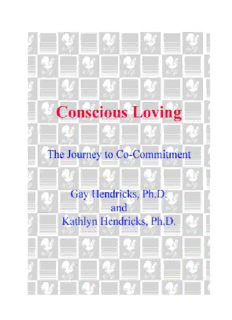
Conscious Loving: The Journey to Co-Commitment PDF
Preview Conscious Loving: The Journey to Co-Commitment
By Gay Hendricks, Ph.D. CONSCIOUS BREATHING By Gay Hendricks, Ph.D. and Kate Ludeman, Ph.D. THE CORPORATE MYSTIC By Gay Hendricks, Ph.D. and Kathlyn Hendricks, Ph.D. AT THE SPEED OF LIFE CONSCIOUS HEART We dedicate this book to our amazing children, Amanda and Chris, who have shown us that there is a new and better world of relationships available for the human family. A CKNOWLEDGMENTS We are deeply grateful to the thousand or so couples, and the more than twenty thousand clients and workshop participants with whom we have worked over the past two decades. Their courageous struggles toward co-commitment are the proving ground for the ideas in this book. We are grateful to all the therapists who have taken our professional trainings. They have given us the gift of their compassion, caring and critical feedback. Heartfelt thanks are due to those colleagues who gave us feedback on the manuscript as it evolved. We offer a bouquet of thanks to Toni Burbank, whose editorial touch is both masterful and exquisitely light. A particularly deep bow goes to Sandy Dijkstra, dream agent and agent of dreams. To our parents— Norma Hendricks and Polly and Bob Swift— we give a hug of thanks for everything they are and have done. We are deeply grateful for John Bradshaw, for his loving spirit and his great contribution to our society’s healing. C ONTENTS F by John Bradshaw OREWORD P ROLOGUE PART ONE O C L : T J B NE ONSCIOUS OVING HE OURNEY IN RIEF Unconscious Loving and Co-Dependence? What Is Co-Commitment? The Birth of Unconscious Loving in Childhood The Specific Moment When Unconscious Loving Emerges Beginning Your Journey to Co-Commitment Three Fundamental Requirements for Co- Committed Relationships T T M W U L B WO HE OMENT HEN NCONSCIOUS OVING EGINS The Hidden Influence of the Past The Moment in Detail Withholding Leads to Withdrawal and Projection Unconscious Deals The Heart of the Matter T T N T U L HREE HE INE RAPS OF NCONSCIOUS OVING F T S S C -C OUR HE EVEN TEPS TO O OMMITMENT Step One: Commitment Step Two: Learning to Love Yourself Step Three: Learning to Feel Step Four: Claiming Creativity Step Five: Learning to Tell the Microscopic Truth Step Six: Keeping Your Agreements Step Seven: Learning to Live in a State of Continuous Positive Energy F T O P Y N S C -C IVE HE NLY ROBLEM OU EED TO OLVE IN A O OMMITTED R ELATIONSHIP Deflecting Positive Energy The Co-Committed Alternative to the Upper Limits Problem S A N M R C IX EW ETHOD OF ESOLVING ONFLICT The Co-Committed Problem-Solving Process S C -C S C H EVEN O OMMITTED TRATEGIES FOR OMMUNICATING AND ANDLING D E IFFICULT MOTIONS Sources of Distorted Thinking About Emotions Defining Your Boundaries Recognizing Your Feelings Distinguishing Thoughts from Feelings Co-Committed Communication Skills The Co-Committed Alternative E H K P I P IGHT ow TO EEP THE AST FROM NTRUDING ON THE RESENT Projection Is Often the Culprit Projecting Past Authority Issues onto the Present Traumas Habit Patterns Healing the Past Completions 198 N W D W Y F S INE HAT TO O HEN OU EEL TUCK The Stuckness Process C E N W I ONCLUSION NVISIONING A EW ORLD OF NTIMACY PART TWO T C -C P : A T Y HE O OMMITMENT ROGRAM CTIVITIES FOR RANSFORMING OUR R ELATIONSHIP Introduction Co-Commitment Activities Co-Commitment Learning to Love Yourself Learning to Feel Your Feelings Claiming Creativity Learning to Tell the Microscopic Truth Keeping Your Agreements Learning to Live in a State of Continuous Positive Energy Communications Skills Problem-Solving F OREWORD Conscious Loving is a marvelous addition to the nourishing practical wisdom Gay Hendricks has been offering for a long time. I have learned much about self-love and human emotions from Gay. I have learned about intimacy from Kathlyn and Gay. This book is a product of their co-commitment to all of us. I can’t think of anything more important than conscious loving. Our culture’s severe family problems and massive addictions attest to the unconscious contaminations resulting from our dysfunctional source relationships. Our models of intimacy are patently out of date. They come from a social era that was survivalistic. When survival is at stake, it is good to have one person in charge. It is also good to be co-dependent and non-feeling. Our culture is leisure oriented. The old model is totally inadequate for dealing with the new possibilities for love and emotional intimacy which result from the new leisure. Kathlyn and Gay are offering us a new model. We need it badly. We must help our ailing non-intimate marriages. The marital relationship determines the health of the family to a large degree. In spite of a couple’s best intentions, if they use the old model, their relationship is probably going to fail because the old model is based on an imbalance of power. In this book, the Hendricks teach us that intimacy is only possible when there is a balance of power. Most importantly, they offer us exercises which will help us to achieve this balance of power in our relationships. In fact, the practicality of this book is its greatest asset. The Hendricks offer us a rich array of experiential exercises which can teach us how to love intimately. I consider Gay and Kathlyn to be my teachers. I encourage you to buy this book and use it to the hilt. —JOHN BRADSHAW
Description: